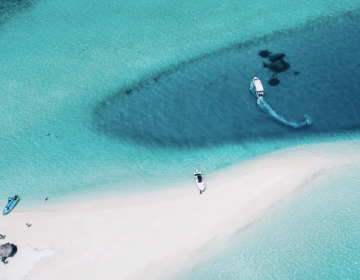If you intend taking a diving course while in the Maldives, you should have a full diving medical checkup before you leave home. In the Maldives, you can have it done at AMDC Clinic or the ADK Hospital in Malé, or at the diving clinic at Bandos Resort. Generally, most dive schools will let you dive or do a course if you complete a medical questionnaire, but a medical checkup is still a good idea. This is especially so if you have any problem at all with your breathing, ears, or sinuses. If you are an asthmatic, have any other chronic breathing difficulties or serious inner-ear difficulties, you will not pass the test and should not do any scuba diving.
Diving may conjure up visions of hungry sharks, fierce moray eels, stinging jellyfish and other aquatic menaces, but these dangers are slight. In most cases, it’s merely a matter of avoiding touching or picking up things which are best left alone.
Cuts, Bites, and Stings
Skin punctures can quickly become infected in hot climates and may be difficult to heal. Treat any cut with an antiseptic such as povidone-iodine. Where possible avoid bandages and Band-aids, which can keep wounds wet.
Though scuba diving has its health considerations (see below), there are certain dangers that anyone snorkeling, swimming, or even wading in Maldivian waters should be aware of. The basic rules of reef safety are:
- Don’t walk on reefs or in the shallow water between reefs
- Don’t eat fish you don’t know about
- Don’t swim in murky water; try to swim when there’s bright sunlight
Coral Cuts
The most likely marine injury is the simple coral cut. Coral is sharp stuff and brushing up against it is likely to cause a cut or abrasion. Since coral kills its prey with poison, you’re likely to get some of that poison in the wound, and tiny grains of broken coral are also likely to lodge there. The result is that a small cut can take a long, long time to heal and be very painful in the process. The answer is to wash any coral cuts very thoroughly with fresh water and then treat them liberally with Mercurochrome or some other antiseptic.
An even better solution is not to get cut by coral in the first place. Don’t walk on reefs, don’t swim over coral flats to go snorkeling, and maintain correct buoyancy and control when diving. In cutting yourself, you’ve probably damaged the coral as well, so exercise care, avoid coral cuts and help preserve the environment at the same time.

Anemone Stings
All coral is poisonous to some extent and brushing against fire coral, or the feather hydroid can give you a painful sting and an itchy rash which takes a long time to heal. Anemones are also poisonous and putting your arm into one can give you a painful sting.
Stone Fish
Stone fish lie on reefs and the sea bottom and are well camouflaged. When stepped on, their 13 sharp dorsal spines pop up and inject a venom that causes intense pain and can cause death. Stone fish are usually found in shallow, murky water, but they can also be found on rock and coral seabeds. They are another good reason not to walk on coral reefs.
Wearing shoes with sturdy soles is the best protection, but if you are unlucky, bathing the wound in very hot water reduces the pain and the effects of the venom. An antivenom is available, and medical attention should be sought as the after-effects can be very long lasting.

Butterfly Cod / Lion Fish
These fish are closely related to the stone fish and have a series of poisonous spines down their back. The butterfly cod, also known as the lion fish or fire fish, is an incredibly beautiful and slow-moving creature – it knows its deadly and doesn’t worry about possible enemies. Even brushing against the spines can be painful, but a stab from them can be fatal. Fortunately, it’s hard to miss a butterfly cod, so unless you step on one or deliberately hit one, the danger is remote.
 Lion Fish
Lion Fish
Sea Urchins
Don’t step on sea urchins as the spines are very long and sharp, break off easily and once embedded in your flesh are very difficult to remove.
Sea Lice
You may encounter these tiny creatures when swimming or snorkeling. They are too small to see, but they cause annoying little stings on exposed skin – they feel like mosquitoes, but you can’t swat them. They don’t cause any lasting discomfort.
Stingrays
Stingrays lie on sandy bottoms, and if you step on one, its barbed tail can whip up into your leg and cause a nasty poisoned wound. Sand tends to drift over stingrays so they can become all but invisible while basking on the bottom. Fortunately, although they may be invisible to you, you are certainly not invisible to them, and stingray usually wakes up and zoom away as you approach. If you’re walking on the sort of shallow sandy surface which rays like, its wise to shuffle along and make some noise. If you’re stung, bathing the affected area in hot water is the best treatment, and medical attention should be sought to ensure the wound is cleaned correctly.
Cone Shells
The white-banded cone shell (Conus omaria) is found in Maldivian waters and can sting dangerously, or even fatally. Other fish and sea creatures can sting or bite or are dangerous to eat.
 Cone Shell
Cone Shell
Fish Bites
Lots of fish will bite you if you put your fingers into their mouths. Many scuba divers used to find this out hand-feeding fish, which is strongly discouraged. A bite from most small fish is nothing more than a playful nip, but stingrays, moray eels and many other large fish can give painful bites and cause injuries. You are unlikely to be bitten if you follow the rules of not feeding or touching any fish.
Fish Poisoning
Ciguatera is a poison which accumulates in fish which graze on certain types of algae. The poison concentrates in other fish further up the food chain. It isn’t the original algae-eating fish which pose the problem; it’s the fish which eat the fish which eat the algae-eating fish. Chinaman-fish, red bass, large rock cod, and moray eels have been implicated, but the danger is remote. Maldivian cooks should know which fish are safe to eat.
Ear Problems
Many divers experience pain in the ears after diving, which is commonly caused by the failure of the ears to compensate correctly for changes in pressure. The problem will usually fix itself, but injuries are often created when people try to treat themselves by poking cotton buds or other objects into the ear.
Decompression Sickness
Decompression Sickness is a severe condition usually, though not always, associated with diver error. The most common symptoms are unusual fatigue or weakness; skin itch; pain in the arms; legs (joints or mid-limb) or torso; dizziness and vertigo; local numbness, tingling or paralysis; and shortness of breath. Signs may also include a blotchy skin rash, a tendency to favor an arm or a leg, staggering, coughing spasms, collapse or unconsciousness. These symptoms and signs can occur individually, or a number of them can appear one at a time.
The most common causes of decompression sickness, or ‘the bends’ as it is commonly called, are diving too deep, staying at depth too long, or ascending too quickly. This results in nitrogen coming out of solution in the blood and forming bubbles, most commonly in the bones and particularly in the joints or the weak spots such as healed fracture sites.
There are other factors which have been shown to have a causal effect in decompression sickness, including excess body fat; heavy exertion prior to, during and after diving, injuries and illness; dehydration; alcohol; cold water; hot showers or baths after diving; carbon dioxide increase (for example through smoking); and age.
Avoid flying after diving, as it causes nitrogen to come out of the blood even faster than it would at sea level. It’s not a good idea to dive within 24 hours before a flight, and certainly not within 12 hours. Low altitude flights, like a helicopter or seaplane transfer to the airport, maybe just as dangerous because the aircraft is not pressurized, though the flights are usually of short duration. Opinions vary as to the risks and the time required to minimize them – a lot depends on the frequency, depth, length of dives over several days before the flight. Seek the advice of an instructor when planning what dives you’d like to do during the final few days of your stay, and try to finish up with shallow dives.
Even if you take all the necessary precautions, there is no guarantee that you will not be stricken by the bends. All divers have a responsibility to be aware of anything unusual about their condition, and that of their diving buddy, after a dive.
The only treatment for decompression sickness is to put the patient in a decompression chamber. There are several in the Maldives, but the best place to go is the Bandos Resort near Malé, which has a trained hyperbaric specialist available. A chamber provides an artificial means of putting a person back under pressure similar to that, or often more significant than, that of the depth at which they were diving so the nitrogen bubbles can be reabsorbed. The time required in the chamber is usually three to eight hours. The treatment is generally effective, with the main problem being caused by a delay in getting the patient to the chamber. If you think that you, or anyone else you are diving with, are suffering from the bends, it is essential to get to a decompression chamber as soon as possible.
 Decompression Chamber
Decompression Chamber




[…] are many ways to dive this channel depending on the current. If the current is not too strong, divers can venture across the entire entrance, and because the channel is not deep, they can finish their […]